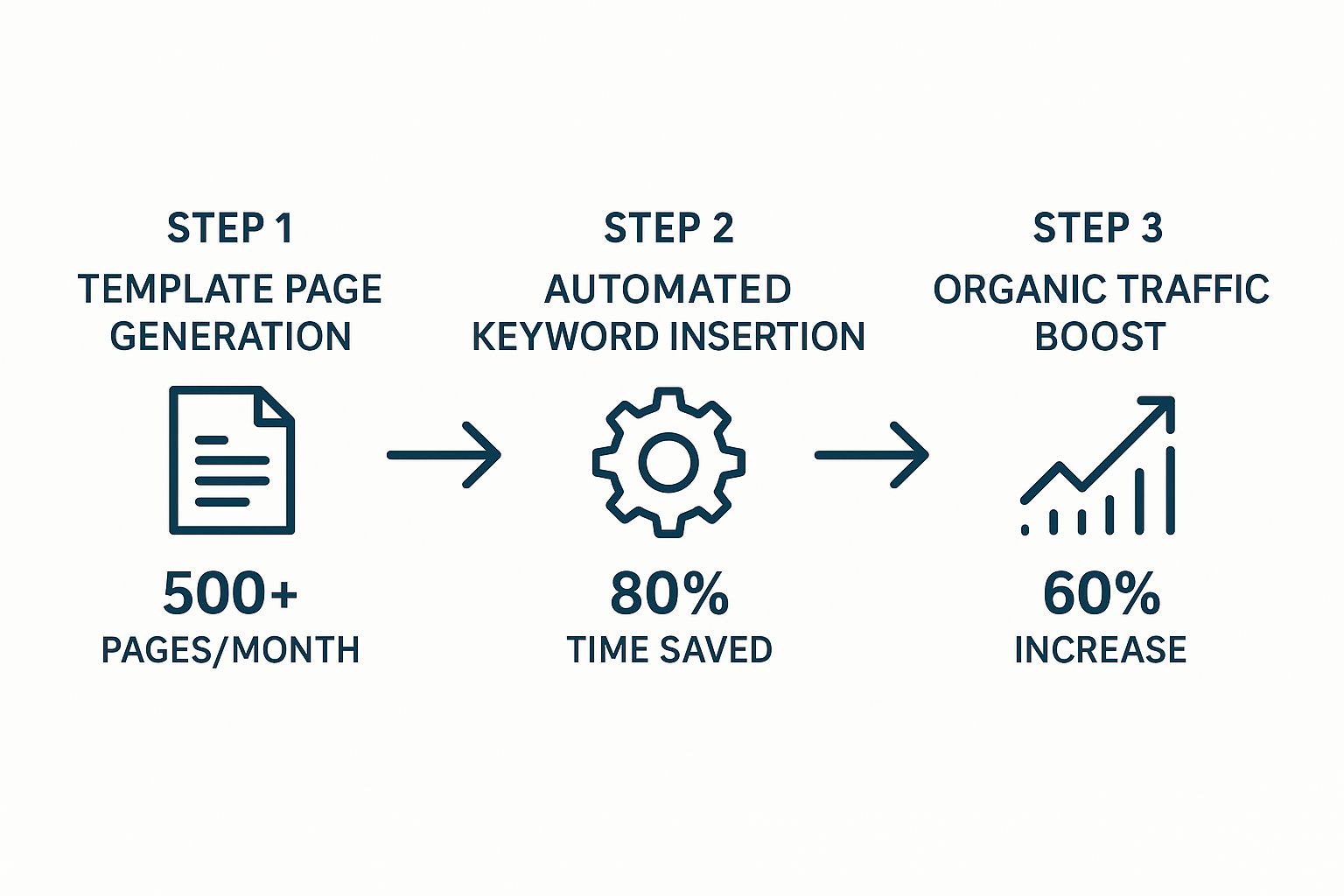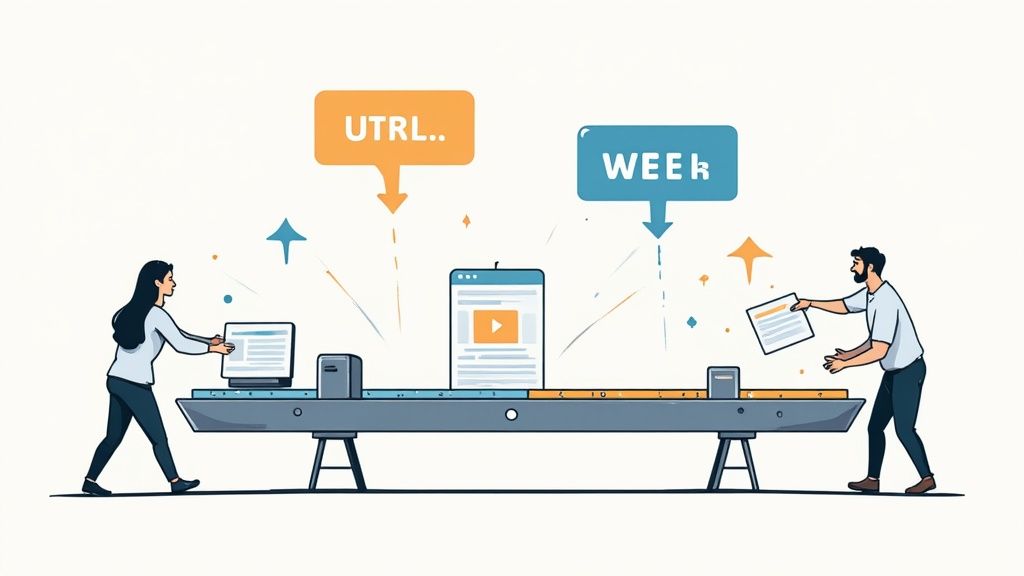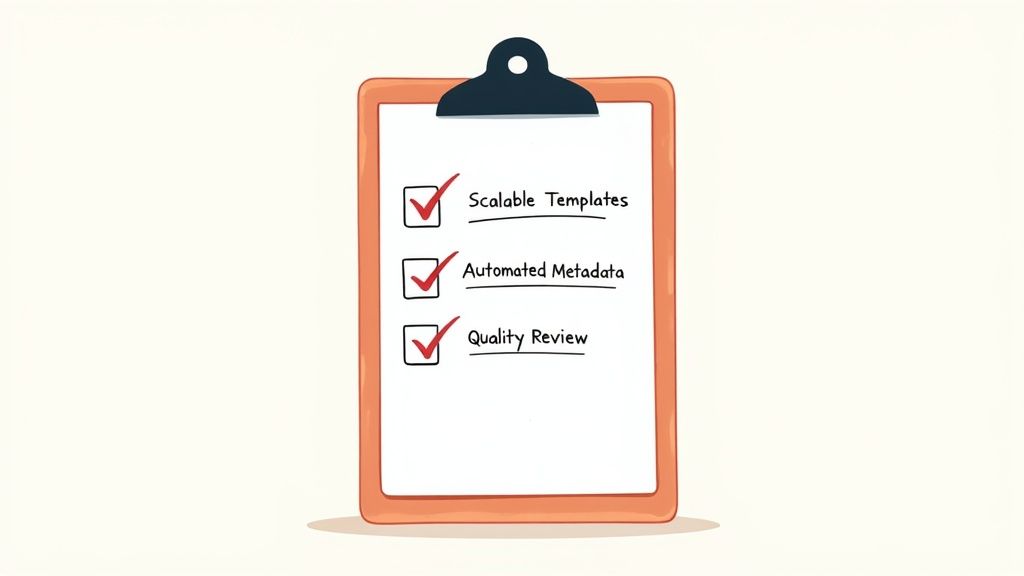Have you ever heard of programmatic SEO? It's a way to automatically create hundreds—or even thousands—of web pages. You do this by mixing data with a single page design, called a template.
Instead of writing every single page by hand, you build a system that makes them for you. This lets you show up in search results for many specific, long-tail keywords. Trying to do this manually would be almost impossible.
Understanding Programmatic SEO in Simple Terms

Think of it like sending out party invitations.
You have one invitation design (the template) and a list of your friends' names and addresses (the data). A program takes your design, adds a different name and address to each one, and prints out a personal invitation for every friend.
Programmatic SEO works the exact same way. You design one main page template. Then, you connect it to a source of data, like a spreadsheet with a list of cities, products, or services. The system then automatically builds a unique, search-friendly page for every item on your list.
A Quick Look at How It Works
The best part? You don't need to be a coding expert to do this. The process is pretty simple and focuses more on smart planning than on complex tech skills.
Here’s a simple breakdown of the steps:
- Find Your Data: First, you need a list. This could be anything—all the cities in a state, every service you offer, or different types of a product you sell. This list is the core of your pages.
- Create a Template: Next, you design a single "master page." This page will be the model for all the pages you're about to create. This is where you set up the structure and decide where the information from your list will go.
- Generate Your Pages: Finally, you use a tool to mix your data with your template. This automatically creates all the individual pages at once.
For WordPress users, the LPagery plugin is a great tool made just for this. It lets you use a simple spreadsheet to create thousands of pages in bulk without writing any code.
This method has been a huge help for companies that want to grow their presence online. Big names like Zillow and TripAdvisor use this approach to get lots of traffic by targeting very specific keywords. It allows them to get visitors from searches that would be too expensive and slow to target one page at a time.
To really get the idea, think about how something like AI automated pin generation is changing how people create content. It's all about moving away from doing tasks one by one and using smart systems to do the hard work for you.
To make the difference even clearer, let's compare the old way with the new way.
Traditional SEO vs. Programmatic SEO
This table shows the main differences between creating content by hand versus using a programmatic approach.
| Aspect | Traditional SEO | Programmatic SEO |
|---|---|---|
| Content Creation | Done by hand, one page at a time | Automated, created in large batches |
| Scale | Limited to a few dozen pages | Easily grows to thousands of pages |
| Keyword Focus | Broad keywords with high search numbers | Specific, long-tail keywords |
| Cost Per Page | High | Very low |
| Time to Publish | Slow (days or weeks per page) | Fast (minutes for hundreds of pages) |
| Best For | Important, core content | Large-scale, data-based pages |
As you can see, programmatic SEO isn't meant to replace traditional SEO. It's about adding a powerful new tool to your strategy that lets you grow on a scale that was hard to imagine before.
How to Do Programmatic SEO
So, how does this all work in real life? Let's look at the process. It really comes down to three main steps. These steps take you from a simple spreadsheet to a large collection of live, search-friendly pages.
I like to think of it like baking a lot of cookies. You wouldn't bake just one cookie at a time, right? You mix a huge batch of dough (your data), use a cookie cutter for the shape (your template), and then bake hundreds of cookies at once (your published pages).
It’s the same idea, just for creating web pages.
Step 1: Gather Your Data
First, you need your ingredients. This is the raw information that will make each page different. Most of the time, this information is kept in a simple spreadsheet. Each row in the spreadsheet stands for a future page, and each column holds a specific piece of information for that page.
What kind of information are we talking about? It could be anything:
- A list of every city and zip code in California.
- Your full product list, with names, details, and prices.
- A database of job titles matched with different industries.
If you use WordPress, a plugin like LPagery makes this part easy. It lets you connect a spreadsheet right to your site, turning each row of data into a new page automatically. We have a great tutorial that shows you exactly how to create pages from a spreadsheet if you want to see it in action.
Step 2: Design Your Page Template
Once your data is ready, the next step is to create a blueprint. This is your master page template. It will set the layout and structure for every single page you create.
You design this page just like any other page on your website. The big difference? Instead of writing the final text and adding images directly, you put in special placeholders that match the columns in your spreadsheet. For example, you might add a {{city_name}} placeholder where you want the city’s name to appear.
A key part of making these pages feel unique is using custom images. Learning how to use dynamic image generation is a great move here. It lets you create custom-branded images for every single page without doing any extra work.
Step 3: Generate and Publish
And now for the fun part. With your data and template ready, you just tell the system to start. The software goes through your spreadsheet, row by row, grabbing the data and putting it into the placeholders on your template. It does this over and over, creating hundreds or even thousands of unique pages in minutes.
This whole three-step process is made to be very efficient and get huge results.

As you can see, this is more than just a small change. We're talking about a process that can help you create over 500 pages a month, save 80% of your time, and get a 60% increase in visitors from search engines. It completely changes the scale you can work at.
Real-World Examples of Programmatic SEO Success

Learning the theory is good, but seeing programmatic SEO in action makes it all click. Some of the biggest websites you use every day built their growth on this exact method. They turned simple data into a huge amount of traffic from search engines.
These examples show how a smart template and the right data can take over search results.
Take Zapier, the tool that connects almost any app you can think of. They have a page for every possible app connection. Ever searched for "connect Gmail to Slack" or "link Trello with Google Calendar"? You probably landed on a Zapier page.
They found a simple pattern in what people were searching for: [App A] + [App B] + integration. By building one strong template and using thousands of app combinations as data, they created a massive library of very specific pages that solve a clear user need.
How Companies Win with This Strategy
Wise (which used to be called TransferWise) is another great example. Their business is all about changing money from one currency to another. So, they created a unique page for every currency pair you can imagine. "Convert USD to EUR," "send GBP to JPY"—if you can think of it, they have a page for it.
Each page gives you a live currency converter and just enough useful information. This lets them get traffic from people who are just about to transfer money. It’s a brilliant move.
And the results are amazing. Zapier gets around 5.8 million monthly visits by covering all of these specific, long-tail keywords. Wise does even better, bringing in over 60 million visits by using data to build a traffic machine that's nearly impossible for others to copy.
The big idea here is simple but very powerful. Find a user need that repeats, get the data to solve it, and build a system that can create a page for every single version of that need.
But this is not just for huge companies. Smaller businesses have seen amazing results, too. One SEO agency, for example, was able to create 1,000 SEO pages in just 20 minutes and double their organic traffic. That shows you just how powerful this approach can be when you have the right tools.
These are perfect examples of programmatic SEO done right—a smart, scalable way to meet user needs.
The Key Benefits of Using Programmatic SEO
So, why should you bother setting up a programmatic SEO strategy? The rewards are huge, and they go beyond just making more pages. Think of it as building a smarter, faster growth engine for your website. The most obvious benefit right away is the ability to grow on a massive scale.
Imagine you’re a plumber who wants to rank in search results for every service you offer in every neighborhood you serve. Creating those pages by hand—hundreds, maybe thousands of them—would take a team months. With a programmatic approach, you can create all of them in one afternoon. You’re growing your online presence at a speed that's just not possible by hand.
Target Very Specific Customer Needs
Another huge plus is being able to target super-specific, long-tail keywords. These are the detailed phrases people type into search engines when they know exactly what they're looking for, like "emergency plumber in Brooklyn with 24/7 service."
On their own, these keywords don’t get a lot of search traffic. But here's the secret: they are pure gold. Someone searching with that much detail is often ready to buy. Programmatic SEO lets you create a page for thousands of these searches, connecting you directly with customers who are ready to make a purchase.
By answering these very specific needs at a large scale, you're not just getting traffic. You're attracting visitors who are much closer to buying, which often leads to more sales.
This whole process is also very efficient. Instead of spending hundreds of hours writing pages one by one, you invest that time upfront to build a great template and organize your data. This saves you countless hours for other important parts of your business. If you're on WordPress, you can look into some of the best WordPress mass page generators to make this even easier.
Build a Strong Competitive Advantage
Finally, when you do this right, you create a powerful competitive advantage. You build such a massive and valuable library of content that it becomes very hard for your competitors to catch up.
By covering every possible angle of a topic, you show Google that your site is the top expert. This deep, useful library of content makes your search rankings more stable and much harder for others to beat in the long run.
Getting Started With Programmatic SEO in WordPress

This screenshot gives you a look at the simple screen of the LPagery plugin. It's a powerful tool for doing programmatic SEO right inside your WordPress dashboard. It's made to connect a data source, like a simple spreadsheet, directly to your page templates.
Ready to jump in and build your first project? The best part is, you don't need to be a developer. If your site runs on WordPress, the whole process is pretty easy when you have the right tools.
We're going to walk through how to start a programmatic SEO campaign using LPagery. It was built to turn your data into hundreds of unique pages without you needing to touch any code. The plugin handles all the technical work, letting you focus on what really matters—creating great content.
Step 1: Prepare Your Data in a Spreadsheet
Everything starts with your data. This is the foundation.
Open a new spreadsheet in Google Sheets or Excel and start thinking about the pages you want to create. Each row in this sheet will become a brand-new page on your site. Each column will hold a unique piece of information for that page.
Let's say you're a local service business. Your columns might look something like this:
- City Name: The specific city you're targeting (e.g., "Brooklyn").
- Service: The service you offer there (e.g., "Emergency Plumbing").
- Unique Selling Point: A short, custom sentence for that location (e.g., "Proudly serving the Brooklyn area for over 10 years.").
Keep it simple, especially when you're starting out. The goal is a clean, organized spreadsheet that will feed your pages.
Step 2: Design a Single Template Page
Next, go into your WordPress dashboard and create a new page just like you normally would. This page is going to be your master "template." Go ahead and design it with the exact layout you want all your new, automatically created pages to have.
The magic happens here: instead of writing normal text, you'll use simple placeholders that match your spreadsheet columns. LPagery uses a simple format that looks like this: {{column_name}}.
So, your page title could be something like: {{Service}} in {{City Name}}.
And in the body of the page, you might write: {{Unique Selling Point}}. You're basically creating a blueprint that the plugin will use to automatically fill in your data for every single row.
By focusing on one high-quality template, you make sure that all 500 or more of your new pages will be well-designed, easy to use, and look consistent. This is much more efficient than trying to build each page by hand.
Step 3: Configure the Plugin and Generate Pages
Once your template page looks good and your data is organized, it's time to connect everything.
Inside the LPagery plugin settings, you’ll link your spreadsheet to the template page you just created. You’ll tell the plugin which column to use for the page title and which one to use for the page's URL address.
After a few quick clicks to confirm your settings, you're ready to go. Hit the "Generate" button, and watch LPagery do its work. It will create a unique, search-friendly page for every single row in your spreadsheet. It's that simple.
For a more detailed walkthrough, you can follow this excellent guide on how to do programmatic SEO in WordPress with plugins. It's a great way to grow your content and start reaching new people with very little manual work.
To help you stay organized, here's a simple checklist for your first project.
Your First Programmatic SEO Project Checklist
This checklist breaks down the key steps to get your first programmatic SEO project started using WordPress and LPagery. Follow these actions to make sure everything goes smoothly.
| Step | Action Required | Helpful Tip |
|---|---|---|
| 1. Ideation | Think about the type of pages you want to create (e.g., "service in city"). | Start with a simple keyword pattern that you know your customers are searching for. |
| 2. Data Prep | Create a spreadsheet with columns for each piece of info (city, service, etc.). | Double-check for typos! A clean spreadsheet prevents errors when you create the pages. |
| 3. Template | Design a single, high-quality "template" page in WordPress. | Focus on user experience. Make sure the page is easy to read, navigate, and looks good. |
| 4. Placeholders | Add placeholders like {{city_name}} to your template where data will go. |
Use placeholders in your page title, meta description, and throughout the content. |
| 5. Plugin Setup | Install and set up the LPagery plugin, connecting your spreadsheet. | In the settings, choose which column will create the URL address for clean, SEO-friendly links. |
| 6. Generation | Click the "Generate Pages" button in LPagery and let it run. | For big projects (500+ pages), let the process finish without closing your browser. |
| 7. Review | Check 5-10 of the new pages to make sure everything looks right. | Look for any formatting issues, broken images, or placeholders that didn't fill in correctly. |
Following these steps will give you a solid plan for a successful campaign. Once you're comfortable with the basics, you can start trying more complex data and templates.
Common Mistakes to Avoid on Your Journey
Programmatic SEO is a powerful tool, but it's easy to get it wrong. Jumping in without a solid plan can create more problems than it solves. Let's walk through the most common mistakes so you can avoid them.
The single biggest mistake is making "thin" or low-value content. Just because you can create thousands of pages doesn't mean you should—at least not if they don't actually help anyone. Google's one and only job is to give people useful answers. Every single page you create must solve a real problem or answer a specific question.
Another common error is creating pages that are almost identical. Yes, your pages will share a template, but each one needs to feel unique. The secret here is using different and interesting data. Don't just change a city name. Instead, include unique local details, specific service types, or relevant facts for that area. This is how you make sure every page offers real value.
Ignoring User Needs and Technical SEO
It’s surprisingly easy to get so focused on spreadsheets and templates that you forget about the actual person searching. You have to think about what the user wants. What is someone trying to do when they type in that search term? If your page doesn't give them a clear, direct answer, they'll leave.
This focus on quality and user experience has become even more important as programmatic SEO has grown. In the early days, many strategies were about creating static pages from a single list. Now, the game is moving toward dynamic content that pulls in real-time information and even uses AI to stay fresh. That’s a huge factor for search rankings today.
Remember, the goal isn’t just to make pages. It’s to create a valuable resource. Every page should be a helpful destination on its own.
Finally, don't forget the basics of technical SEO. Once you've created all these new pages, you have to make sure Google can actually find and read them. That means creating a sitemap and building internal links that guide search engine bots right to your new content.
If you want a deeper look at how this works, our guide on how to bulk create pages in WordPress explains how modern tools can handle these technical tasks for you.
Still Have Questions About Programmatic SEO?
Alright, we’ve covered a lot of ground. But it’s totally normal to still have a few questions. Let's tackle some of the most common ones I hear from people just starting out.
This section will give you clear, simple answers to help you feel confident about moving forward.
How Does This Actually Work in Practice?
I get it—the idea can sound a little confusing at first. But the actual process is pretty simple.
It all starts with putting your information into a spreadsheet. Think of each row as a future webpage and each column as a unique piece of information for that page.
Next, you'll design a single "template" page on your website. This page is your blueprint, designed with special placeholders where your data will go. For example, your page title might look something like this: "Our {{Service}} in {{City}}."
Finally, you use a tool to mix your data with your template, which automatically creates hundreds or even thousands of unique pages. If your site is on WordPress, a plugin like LPagery is built for exactly this. It connects your spreadsheet to your template and does all the hard work—no coding needed.
Isn't This Just a Fancy Word for Spam?
Nope, not when you do it right. And this is a very important difference.
The difference comes down to one word: value.
Spammy, auto-generated content is thin, repetitive, and offers zero help to the user. It's created only to try and trick the system.
Good programmatic SEO, on the other hand, is about creating genuinely useful pages on a large scale. Each page should answer a very specific question or solve a real problem for the visitor. The goal is to build out a valuable, complete resource—not just to flood Google with junk.
The rule of thumb is this: every single page you generate must be helpful on its own for a real person. If it doesn't pass that test, it's not a good fit for this strategy.
What Kind of Websites Should Use This Strategy?
Programmatic SEO is a great tool for websites that can use large sets of data to answer very specific user searches. It’s a huge help for:
- Directories and Marketplaces: Think of big sites like Zillow with its property listings or TripAdvisor for hotels. They are experts at this.
- E-commerce Stores: Perfect for creating pages for every product color, size, or style you sell.
- Local Service Businesses: This is how a plumber or an electrician can create a page for every single service they offer in every single neighborhood they cover.
- SaaS Companies: A great way to build pages for every software program their tool connects with.
Basically, if your business uses information that follows a repeating pattern, this approach can be an amazing way to grow your online presence.


